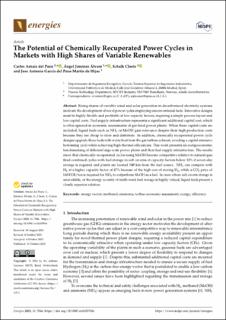| dc.contributor.author | Arnaiz del Pozo, Carlos | |
| dc.contributor.author | Jiménez Álvaro, Ángel | |
| dc.contributor.author | Cloete, Schalk Willem Petrus | |
| dc.contributor.author | de Hijas, Jose Antonio Garcia | |
| dc.date.accessioned | 2024-04-11T13:06:21Z | |
| dc.date.available | 2024-04-11T13:06:21Z | |
| dc.date.created | 2023-11-15T13:42:55Z | |
| dc.date.issued | 2023 | |
| dc.identifier.citation | Energies. 2023, 16 (20): 7046. | en_US |
| dc.identifier.issn | 1996-1073 | |
| dc.identifier.uri | https://hdl.handle.net/11250/3126151 | |
| dc.description.abstract | Rising shares of variable wind and solar generation in decarbonized electricity systems motivate the development of novel power cycles employing unconventional fuels. Innovative designs must be highly flexible and profitable at low capacity factors, requiring a simple process layout and low capital costs. Fuel supply infrastructure represents a significant additional capital cost, which is often ignored in economic assessments of gas-fired power plants. When these capital costs are included, liquid fuels such as NH3 or MeOH gain relevance despite their high production costs because they are cheap to store and distribute. In addition, chemically recuperated power cycle designs upgrade these fuels with waste heat from the gas turbine exhaust, avoiding a capital-intensive bottoming cycle while achieving high thermal efficiencies. This work presents an exergoeconomic benchmarking of different large-scale power plants and their fuel supply infrastructure. The results show that chemically recuperated cycles using MeOH become competitive relative to natural-gas-fired combined cycles with fuel storage in salt caverns at capacity factors below 32% if seven-day storage is required and plants are located 500 km from the fuel source. NH3 can compete with H2 at a higher capacity factor of 47% because of the high cost of storing H2, while a CO2 price of 140 EUR/ton is required for NH3 to outperform MeOH as a fuel. In cases where salt cavern storage is unavailable, or the energy security of multi-week fuel storage is highly valued, liquid fuels present a clearly superior solution. | en_US |
| dc.language.iso | eng | en_US |
| dc.publisher | MDPI | en_US |
| dc.rights | Navngivelse 4.0 Internasjonal | * |
| dc.rights.uri | http://creativecommons.org/licenses/by/4.0/deed.no | * |
| dc.title | The Potential of Chemically Recuperated Power Cycles in Markets with High Shares of Variable Renewables | en_US |
| dc.title.alternative | The Potential of Chemically Recuperated Power Cycles in Markets with High Shares of Variable Renewables | en_US |
| dc.type | Peer reviewed | en_US |
| dc.type | Journal article | en_US |
| dc.description.version | publishedVersion | en_US |
| dc.rights.holder | © 2023 by the authors. Published by MDPI. | en_US |
| dc.source.pagenumber | 22 | en_US |
| dc.source.volume | 16 | en_US |
| dc.source.journal | Energies | en_US |
| dc.source.issue | 20 | en_US |
| dc.identifier.doi | 10.3390/en16207046 | |
| dc.identifier.cristin | 2197090 | |
| dc.source.articlenumber | 7046 | en_US |
| cristin.ispublished | true | |
| cristin.fulltext | original | |
| cristin.qualitycode | 1 | |

